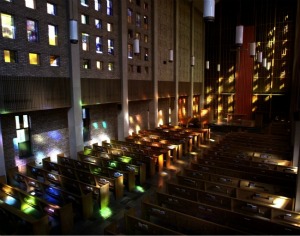
Artistic meditations on the last actions of Jesus as created by Vanderbilt Divinity School students, faculty and staff will be featured April 4 at Benton Chapel.
Participants will use mixed media, photography and other forms of art for their interpretations at 14 “stations” lined along the walls of Benton Chapel. The public is invited to enjoy the blend of worship and art at a service scheduled from 10:10 to 11 a.m. In addition, the exhibit will remain on display after the service until 2 p.m.
“Stations of the Cross is a Roman Catholic tradition developed over many centuries that we invite people of all faiths and backgrounds to experience,” said Amy Steele, assistant dean for student life at Vanderbilt Divinity School, on behalf of the Vanderbilt Divinity School Worship Committee.
Bruce Morrill, the Edward A. Malloy Professor of Catholic Studies at Vanderbilt, will serve as the presider with Vanderbilt Divinity students assisting in other roles.

The Stations of the Cross has its roots in ancient Christianity, according to Morrill, who is a Jesuit priest. “People as early as the time of Constantine would make pilgrimages to Jerusalem to visit a series of designated sites along a way that eventually acquired the name Via Dolorosa,” he said. “To this ‘Way of Sorrows’ was attached the tradition that Jesus’ mother, the Blessed Virgin Mary, had visited daily the sites of her son’s suffering.”
The devotion spread from the Holy Land back to Europe. Over the centuries, as few were able actually to make pilgrimage to the Middle East, practices evolved for setting up in chapels, cloisters and eventually churches a series of crosses to serve as “stations” at which the faithful would pause to contemplate Christ’s Passion.
Morrill noted that since the Stations of the Cross is not an official rite of the Roman Catholic Church, the stations allow for much creativity in the service. “The stations continue to serve as a learning tool with children and as a malleable devotion suited to new prayers, artistic renderings and even social-justice meditations for the faithful of all ages in various contexts.”
“Stations of the Cross: A Holy Week Interpretation” is co-sponsored by the Divinity School’s Worship Committee and Religion in the Arts and Contemporary Culture Program along with the Office of Religious Life.
For more information, contact Monica Weber at monica.l.weber@vanderbilt.edu.